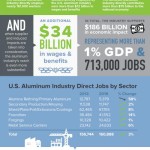Throughout ARPN’s work, we have consistently highlighted the geopolitical dimension of mineral resource policy. Where we source (or fail to source) our metals and minerals is an often forgotten – or ignored – factor, with implications for our domestic manufacturers, and, at times, even for our national security.
Case in point – and in keeping with our current focus – Scandium. As we pointed out last week, the main producers for this co-product mineral, which is “ready to take off,” currently are China, Kazakhstan, Russia and Ukraine, none of which is among our strongest trading partners.
Russia is now stepping up its Scandium game. As reported by Platts, Russian Aluminum producer Rusal has just announced production of high purity (exceeding 99%) scandium oxide for the first time at its Urals smelter – an announcement following the launch of a pilot project for processing scandium concentrate into scandium oxide from red mud, a byproduct of alumina refining. Target production — 96 kilograms per year; not quite 4 pounds per week — shows why Scandium is arguably the rarest of the rare earths.
The announcement ties into the overall context of Scandium’s growing potential, particularly in the context of the aluminum-scandium alloys we discussed last week.
Russian demand for Scandium has soared in recent years due to its use in various defense applications, including the 5th generation fighter, as well as its modernized version, and may well increase as Russia researches Scandium usage in combat equipment.
Meanwhile, while some developers are studying the possibility of including co-product development of scandium into their portfolio, the U.S. at present does not produce any scandium, even though the Defense Logistic Agency in 2013 deemed the material “critical” from a national security perspective.
This year’s U.S. Presidential campaign has sucked up a lot of oxygen — which is about the only element mentioned by the major candidates, despite the fact that any discussion of manufacturing, technology or economic competitiveness is rooted in raw material access. Perhaps after November, our policy makers will be able to focus their attention on our growing mineral resource dependencies, and devising policies that help American manufacturers gain access to critical materials – the way to which (case in point Scandium) often leads “through the Gateway.”





